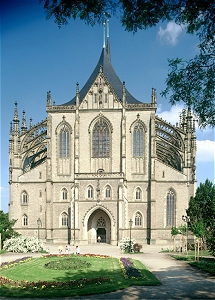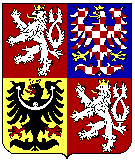


 The Czech Republic boasts a vast cultural and
historical heritage in the form of castles, chateaux, monasteries and fortified
towns, as well as small relics of ecclesiastical architecture. Set romantically
in the countryside, they all are the mute witnesses from bygone times. Numerous
wonders of technology, world-renowned Czech goods and the fame of great figures
of the history of art, sport and many other branches of human activity, they all
bear witness to the talent and skill of previous generations of the inhabitants
of the Czech Republic.
The Czech Republic boasts a vast cultural and
historical heritage in the form of castles, chateaux, monasteries and fortified
towns, as well as small relics of ecclesiastical architecture. Set romantically
in the countryside, they all are the mute witnesses from bygone times. Numerous
wonders of technology, world-renowned Czech goods and the fame of great figures
of the history of art, sport and many other branches of human activity, they all
bear witness to the talent and skill of previous generations of the inhabitants
of the Czech Republic.
Celtic tribes left some of the earliest traces - though almost invisible today -
in this country in the form of so-called oppida (large permanent settlements).
The first state entity, the Great Moravian Empire, bequeathed us far more
distinctive relics - the remains of once powerful fortified settlements.
Well-preserved Romanesque monuments, Gothic churches and monasteries, as well as
the historical centres of towns acquaint us with the reign of the monarchs from
the Premyslid and Luxemburg dynasties.
The activities of the most significant monarch from the Luxemburg dynasty,
Charles IV, King of Bohemia and the Emperor of the Holy Roman Empire, have left
an indelible mark on the face of the Czech Lands. Apart from other glorious
deeds, in 1348 Charles founded the Prague University (now named Charles
University), the oldest establishment of its kind to be setup to the north-east
of the Alps.
A number of monuments recall the Hussite Wars, a failed attempt to reform the
Catholic Church at the beginning of the 15th century, one hundred years prior to
similar attempts in Western Europe, as well as the cultural and spiritual
heritage of that time. The historical town of Tábor in Southern Bohemia owes its
foundation to the Hussite movement.
There is a wealth of Renaissance historical monuments, all bearing witness to
the importance of business contacts and the affluence of medieval towns. The
influence of the Italian Renaissance is apparent in particular in Prague,
whereas the Czech Renaissance style has contributed numerous chateaux and even
entire town centres such as those of Telc, Slavonice and Nové Mesto nad Metují.
Touring spectacular Renaissance houses featuring rich sgraffito decoration is
one of the unforgettable experiences available in the Czech Republic.
The fortunes of the Czech Lands were for a long time interwoven with those of
the Habsburg Monarchy. Leaving aside the hardships of the Thirty Years' War and
the disputes between the Czechs and their new rulers,
this period also witnessed the heyday of Baroque architecture. Scattered all
over the country, the rotund domes of chateaux and ecclesiastical structures
testify to the fact that such eminent figures of Baroque art as the
Dienzenhofers and G. Santini were commissioned to create their masterpieces
here. In addition to Baroque churches and chateaux, surrounded by vast parks and
game preserves, the rural countryside, trimmed and landscaped, has acquired new
dominant features in the form of alleys and splendid tree-lined avenues. It was
also at that time that a unique system of fishponds and lakes was completed in
Southern Bohemia. New towns, town quarters and fortresses were built at that
time.
| 7th century AD | Several Slavic clans unite to form a Czech state. |  |
| 830-907 | Great Moravian Empire. | |
| 1085 | Vratislav ll becomes the first Czech king. | |
| 1212 | The rights of the Czech Lands recognised and sanctioned by the Golden Bull of Sicily, the Czech Kingdom becomes part of the Holy Roman Empire. | |
| 1346-1378 | Rule of Charles IV, Holy Roman Emperor and Czech King. | |
| 1347 | Charles IV founds the first institution of higher learning in Central Europe, Charles University. | |
| 1526-1918 | The rule of Habsburgs. | |
| 28 October 1918 | Czechoslovak Republic established. A prosperous independent state, the era of the Presidents T.G. Masaryk and Eduard Benes | |
| 1938 | Munich Agreements presage Nazi occupation of Czechoslovakia and the imposition of German protectorate on Bohemia and Moravia. | |
| May 1945 | Czechoslovakia re-established. | |
| February 1948 | Czechoslovakia becomes a socialist country, a coup installs a Communist Party regime. Apart from a brief reformation spell known as the Prague Spring, the totalitarian regime clings to power until November 1989. | |
| 17 November 1989 | Political change known as the Velvet revolution ends the dominance of the Communist Party, Václav Havel becomes president of a new democratic state. | |
| 1 January 1993 | Czechoslovakia splits into two independent states - the Czech Republic and the Slovak Republic. Václav Havel elected President of the Czech Republic. The Czech Republic consists of three historical lands - Bohemia, Moravia and part of Silesia. Its democratic and plural political system guarantees the elementary civil rights and liberties to all citizens. The economy is based on market principles with a small and decreasing role of the state. The country promotes free decision making and personal initiative of each and every individual. The Czech state strengthens its international standing and becomes part of European and global structures. Since 1999, the Czech Republic has been a member of NATO. | |
| 1 May 2004 | The Czech Republic became a member of the European Union. | |